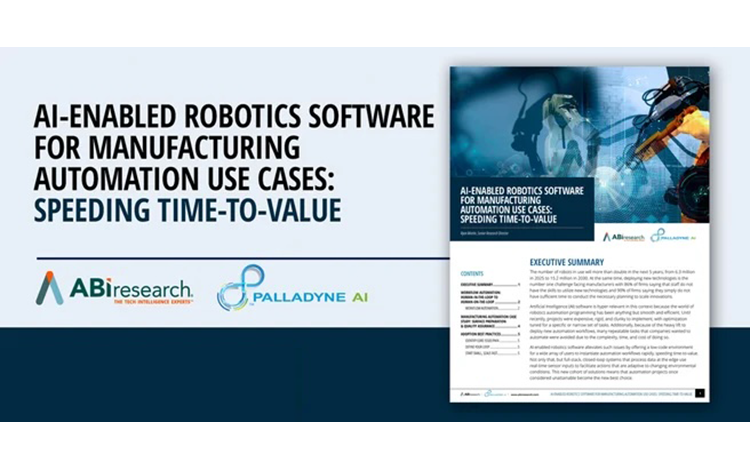ABI Research report explores how AI-enabled robotics automation with a human element boosts manufacturing
The explosive growth and innovative advancements in global robotics are driving a significant demand for increased workflow automation in manufacturing. According to a recent ABI report, robot numbers will more than double in the next five years, rising from 6.3 million in 2025 to 15.2 million in 2030[1]. Despite that increase, manufacturers still face the challenge of deploying new technologies to keep up with demand. With 86% of companies stating that their staff lack the skills to use new technologies, and 90% saying they simply don’t have the time to conduct the necessary planning to scale innovations, the issue remains.
Traditional robotics automation and programming hasn’t always been smooth and efficient. Automation projects can be rigid, inefficient, or expensive to implementandoftenonlyoptimized for a specific or narrow set of tasks.
Emerging AI-enabled robotics software is transforming these frameworks and alleviating many of the traditional automation challenges by offering a low-code/no-code environment that enables the rapid instantiation of automation workflows, thereby speeding up time-to-value, according to a recent report by ABI Research’s data-driven intelligence and global team of analysts.
The new full-stack, closed-loop software processes data at the edge, using real-time sensor inputs to facilitate actions that adapt to changing environmental conditions. This means that automation projects that were once considered unattainable are now the new best approach to manufacturing.
The ABI Research team assesses key technical and business factors that are essential for shaping AI and Machine Learning (ML) market activity and business models, including ML as a service, technology and platform as a service, software licensing, and edge AI hardware and applications. In their research, they found that emerging automation solutions powered by closed-loop AI software are challenging the old ways of thinking and speed time-to-value in manufacturing.
The ABI report delves into the following:
- How AI software completely changes workflow automation by enabling processes that traditionally could not be automated due to the complexity of the process or environment.
- People remain an integral part of the equation for robotics automation, with Human-on-the-Loop (HOTL) implementations being a significant step toward higher degrees of autonomy.
- Best practices for adopting AI-enabled robotics software include three key steps to maximize value in the manufacturing automation journey.
The report also features a case study of a surface preparation and cleaning process for components, showcasing how AI-enabled, closed-loop automation software is revolutionizing the inspection and cleaning process, as well as the speed to market.
ABI Research highlights how implementing Palladyne IQ robotic AI software not only democratizes implementations with practical knowledge through its low-code/no-code environment but also alleviates the need for constant retraining by making automation tasks, such as surface prep and quality assurance, attainable and cost-effective. Such workflow automation ensures greater accuracy and traceability, allowing the overall implementation to adapt to changing components and conditions.
To learn more about how AI-enabled robotics software speeds time-to-value in manufacturing, download the full report.
This blog contains forward-looking statements within the meaning of the Private Securities Litigation Reform Act of 1995, including, but not limited to, statements regarding the capabilities or future capabilities of Palladyne AI’s foundational technology and products and the industries that could benefit from them. Generally, statements that are not historical facts, including statements concerning possible or assumed future actions, business strategies, events, or results of operations, are forward-looking statements. These statements may be preceded by, followed by, or include the words “believes,” “estimates,” “expects,” “projects,” “forecasts,” “may,” “will,” “should,” “seeks,” “plans,” “scheduled,” “anticipates,” “intends” or “continue” or similar expressions. Such forward-looking statements involve risks and uncertainties that may cause actual events, results, or performance to differ materially from those indicated by such statements. Palladyne AI assumes no obligation to update such statements. For a discussion of these and other related risks, please refer to the statements set forth in the reports which Palladyne AI has filed or will file from time to time with the Securities and Exchange Commission. Such filings may be obtained free of charge at www.sec.gov.
[1] ABI Whitepaper: AI-Enabled Robotics Software for Manufacturing Automation Use Cases: Speeding Time-to-Value.



